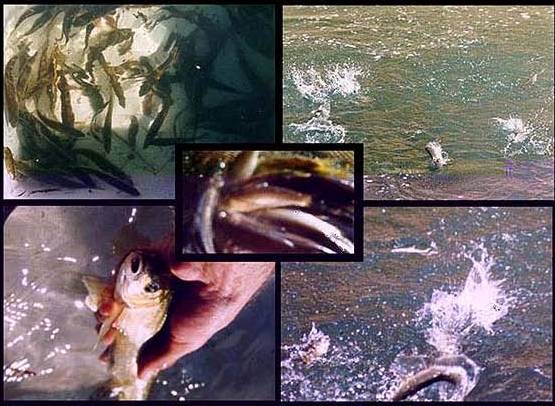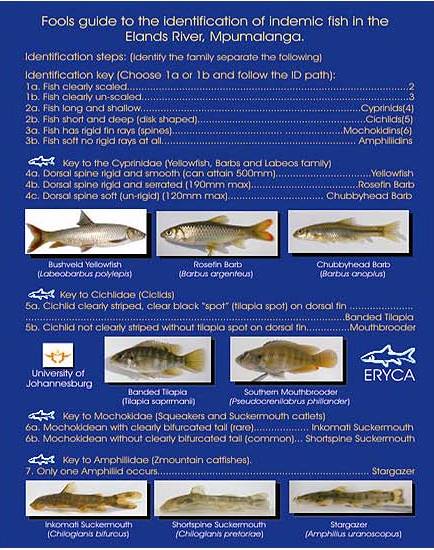The Elands River Yellowfish Conservation Area (ERYCA) Overview The Elands River Yellowfish Conservation Area (ERYCA) is 60km segment of the Elands River (Mpumalanga) which is isolated by two waterfalls. These waterfalls, the Waterval-Boven and Lindenau falls, act as geographical barriers on this small to medium sized river, which has caused a unique array of aquatic organisms to have evolved here alone. One species is the unique population of the Bushveld Smallscale Yellowfish (Labeobarbus polylepis) which is found here, and it is this species which the ERYCA is based on. As a flagship species the ERYCA aims to sustainably utilise this population to conserve the biodiversity of this aquatic ecosystem. Additionally, this segment is one of the last remaining refuges where the critically endangered Inkomati Rock-catlet occurs. These and other species like this, stand to benefit from this ERYCA endeavour. Background The proposition that a segment of the Elands River in Mpumalanga be declared a Yellowfish conservation area was initiated in 2002, by concerned land owners in the Elands Valley, and by additional interested parties.
Participants of the ERYCA establishment workshop. Representation by DWAF, Provincial Parks Board representatives, aquatic biology specialists, FOSAF representatives and local riparian owners and conservancy members.
Relating to the ecology of the Elands River a series of research studies have been conducted in the Elands River (2001 – 2004) and the following important ecology related aspects concerning the system have been revealed:
• The general ecology integrity of the Elands River is high.
• The general water quality in the river (except of a few localised areas) can be considered to be pristine.
• Habitat availability is more than adequate, and • as a consequence the Elands River boasts an extremely high diversity and abundance of biota.
However related concerns have been identified which include:
• The ecological status of the “critically endangered” suckermouth (Chiloglanis Bifurcus) is poorly defined and the continued existence of the species may be threatened. • The unique population of Small-scale Yellowfish (Labeobarbus polylepis) in the Elands River seemed to be unrealistically low. • The high abundances of exotic fish species in the Elands River have the potential to becoming a threat to the aquatic biodiversity of the Elands River as a whole.
The adequate environmental conditions and high abundance of biota in the Elands River make the Elands River system a unique and valuable ecosystem which warrants protection and/or conservation endeavours to sustain and if at all possible improve the health of this system for future generations. The Elands River Yellowfish Conservation Area Conservation of the aquatic biodiversity in the Elands River and South Africa as a whole has become prominent. The recent ‘Fresh water biodiversity conservation strategy’, which has nationally been launched, illustrates the importance of this type of endeavour. The Elands River Yellowfish Conservation Area (ERYCA) has been proposed to act as a management body to:
• Facilitate the aquatic biodiversity and conservation of the segment of the Elands River between the Waterval-Boven waterfall and the waterfall on the farm known as Devilliers, approximately two kilometres upstream of the Elands and Crocodile rivers confluence. • Manage and conserve the unique Small-scale Yellowfish (Labeo-barbus polylepis) colony that occurs in the segment. • Sustain ably utilise the Small-scale Yellowfish colony in the segment to promote an economically sustainable tourism and environmental awareness programme in the area. • Act as a model of, and promote the establishment of aquatic biodiversity conservation areas in Southern Africa.
The Elands River as a candidate for the conservation area The Elands River in Mpumalanga is, from an environmental research point of view, a very well documented aquatic system in South Africa. Therefore allot of information exists relating to the ecology of the system, which will facilitate the management of the ERYCA. The segment (Figure 1) proposed to fall into the ERYCA originates at the Waterval-Boven falls, and ends at a second series of waterfalls on a farm known as “Devilliers” about 60km down stream of the Waterval-Boven falls, two kilometres up stream of the confluence between the Elands and the Crocodile rivers. This segment is ideally suited for the ERYCA primarily because of the mentioned waterfalls, which make the segment geographical isolated. Additionally because of the current diversity and abundance of the biota in the segment, the required biotic ‘resources’ are currently sufficient to establish the ERYCA and promote the sustainable use (Fly-fishing for example) of the Yellowfish population that occurs in this segment.

Figure 1 Diagrammatic representation of the Elands River catchment in Mpumalanga. The proposed boundaries of the ERYCA are represented by the arrows.
Custodians, Stakeholders and primary benefits of the ERYCA The establishment of the ERYCA is being spearheaded by the local landowners, the Elands River Conservancy and by Nature Conservation, all of whom will become the primary custodians of the conservation area. The Department of Water Affairs, research institutions and recreational associations, facilitating the inception of the ERYCA will act as stakeholders of the ERYCA. The custodians of the ERYCA, with support from the stakeholders, will be responsible for the management of the ERYCA. The support required by the custodians and stakeholders includes financial support, environmental awareness and research initiatives, which may include specialist advice and interaction. Finally to promote tourism interaction in the ERYCA the establishment of an education or information centre has been proposed in the segment. Benefits of the ERYCA to the Elands Valley can be separated into social, ecological and economical benefits to the area. The establishment of the ERYCA socially benefit the Elands Valley by possibly:
•• Increasing the social interactions of the custodians and stakeholders. • Improve the overall value and status of the area and environment. This would finally result in the inhabitants reaping economical and ecological rewards from the establishment of the ERYCA.
Ecological benefits that may result from the establishment of the ERYCA include:
•
• The facilitation of the conservation of the area as a whole, an increase in the awareness, understanding and social input into the conservation of the area. • The establishment of the ERYCA may facilitate the protection and conservation of rare, endangered, and sensitive biotic communities.
Finally the establishment of the ERYCA may have economical benefits in the form of:
•
• The generation of sustainable incomes for land owners utilising the ERYCA for recreational and tourism activities. This may be accomplished by an increase in the recreation, ecotourism and as a result an increase in the secondary trade.


